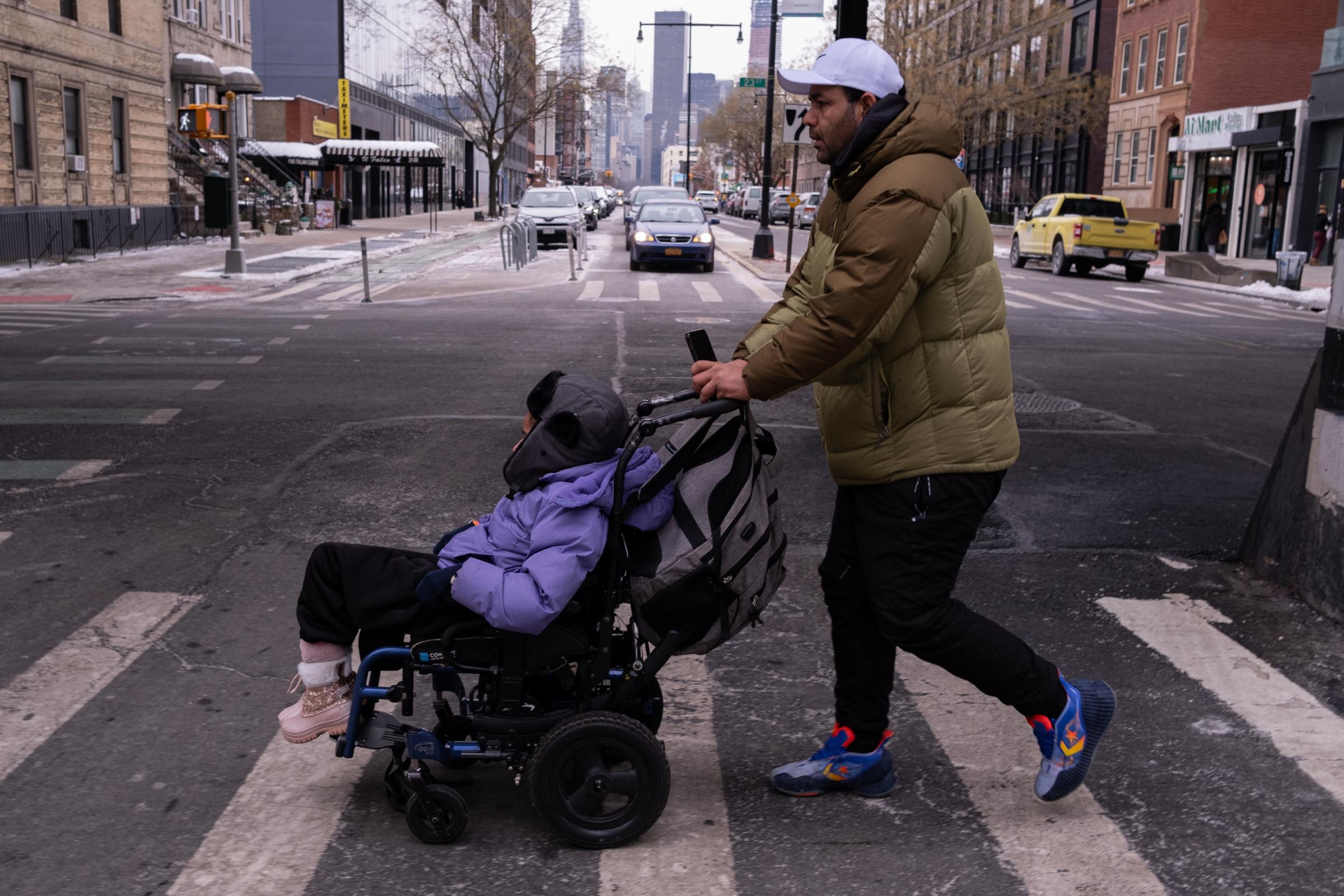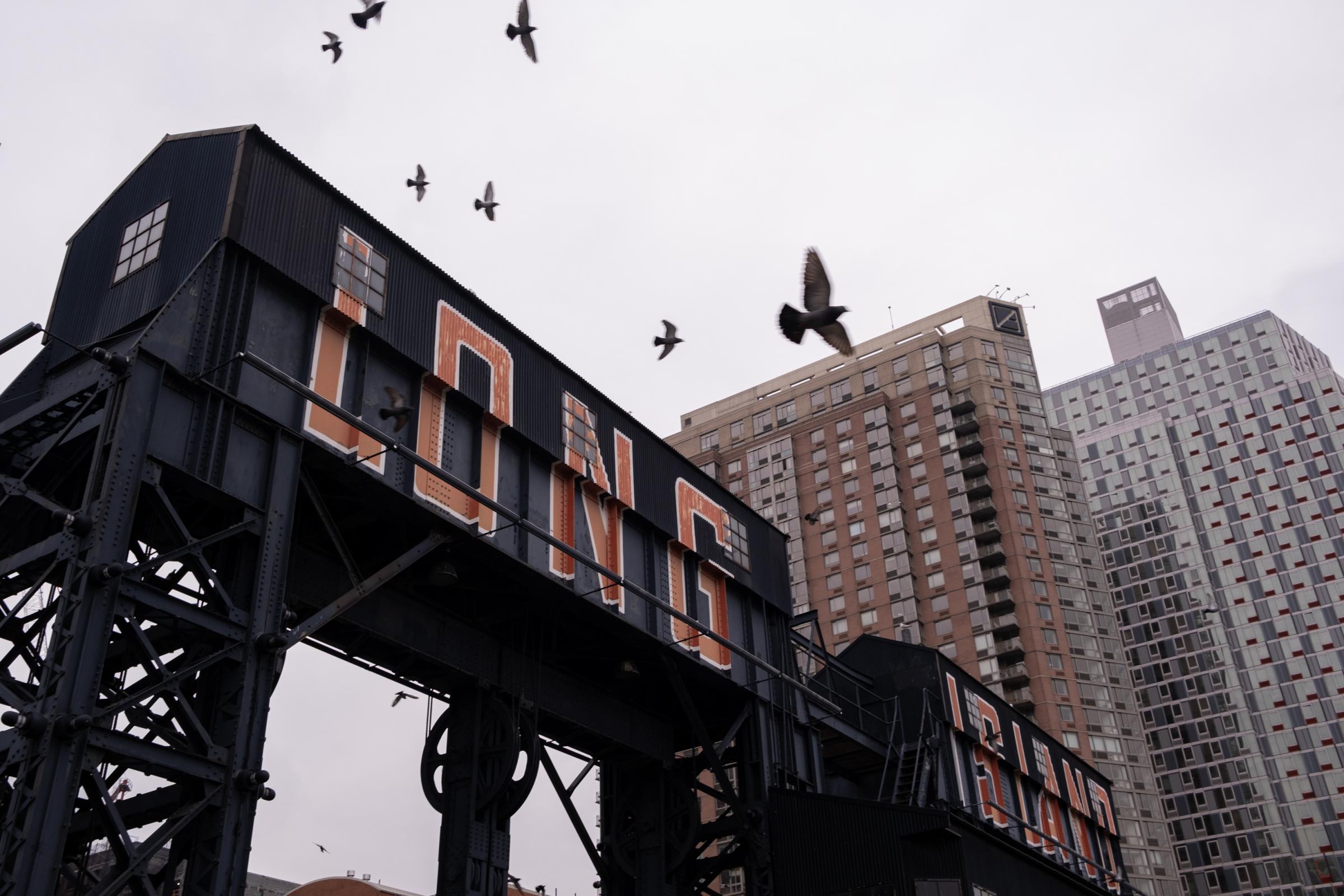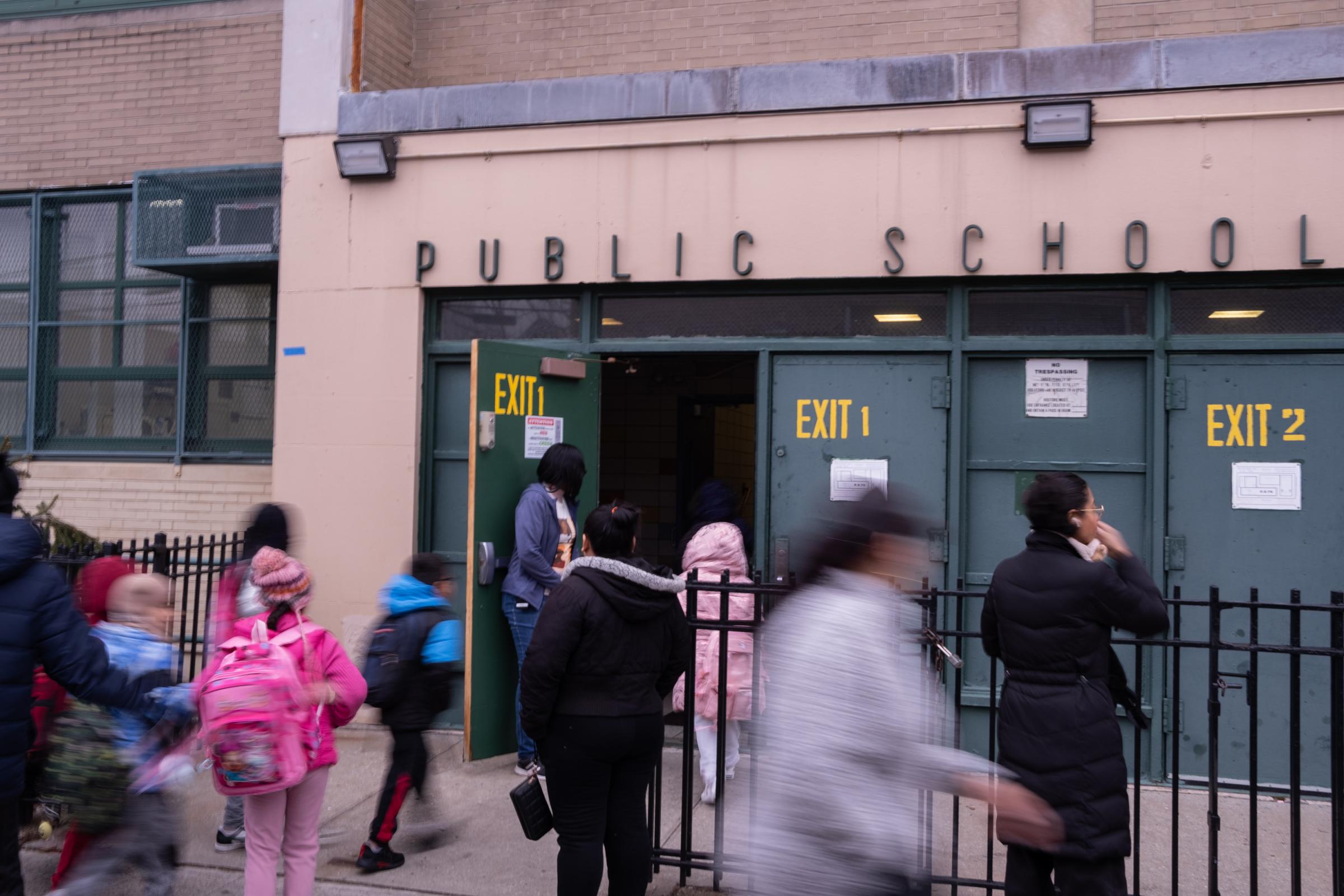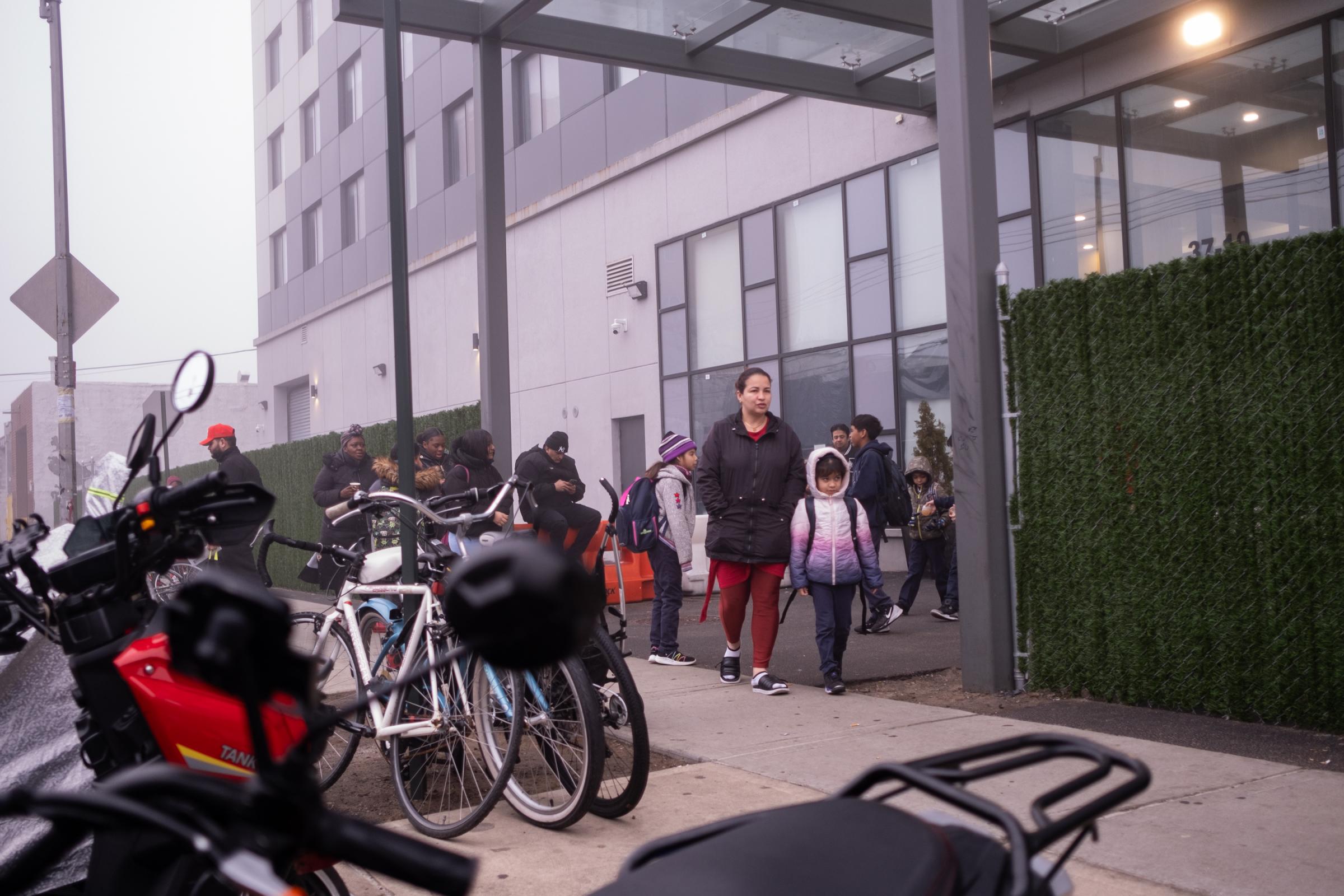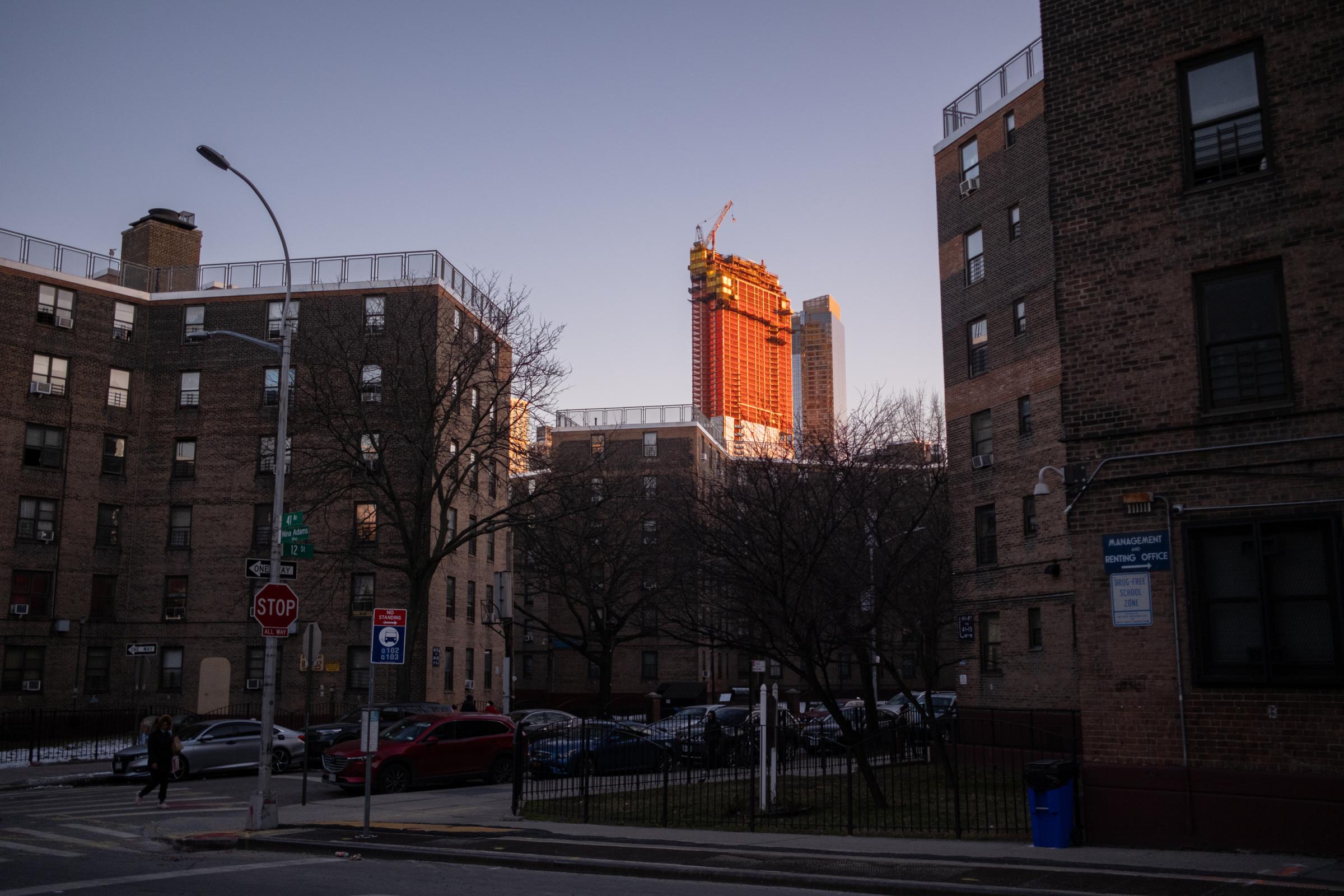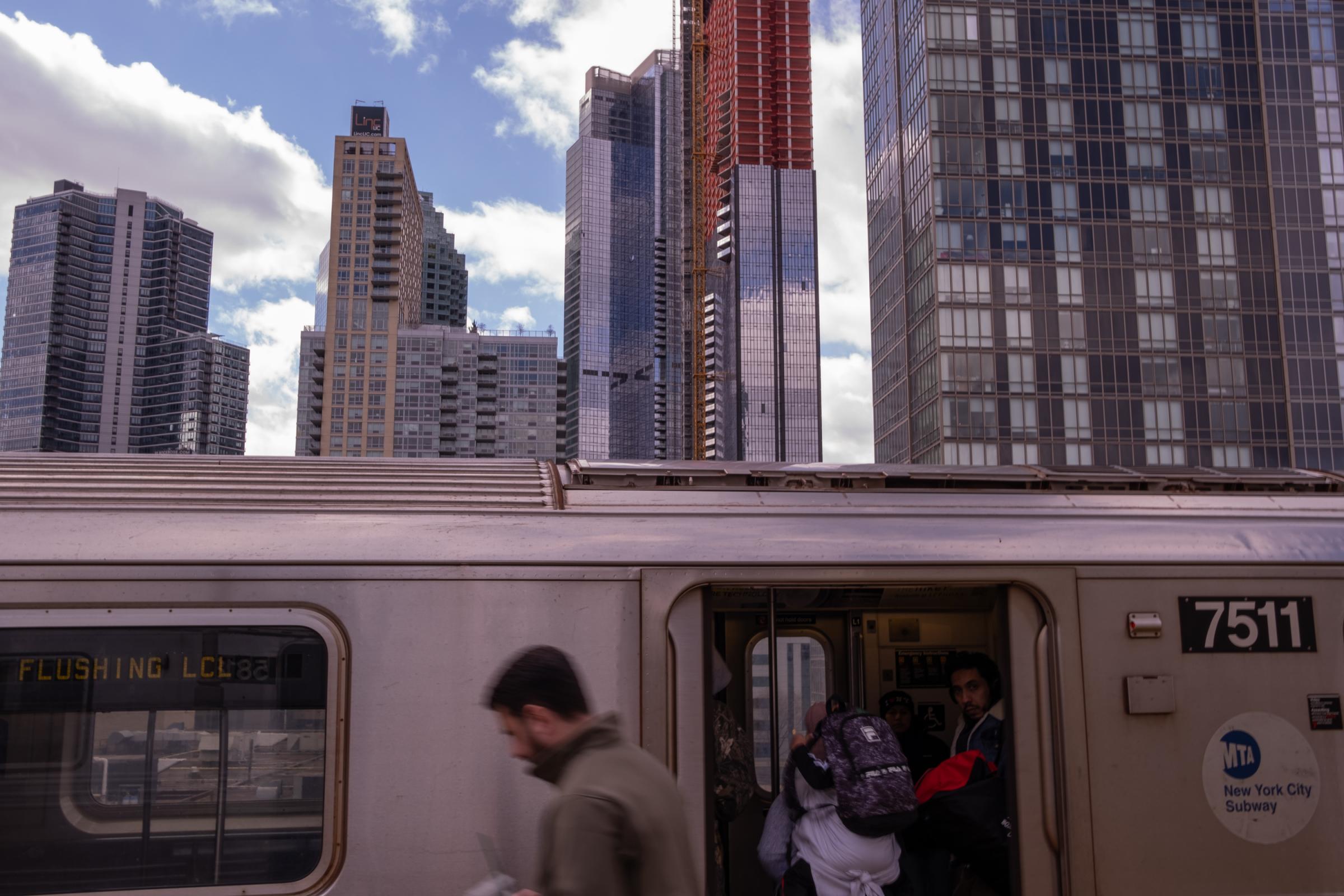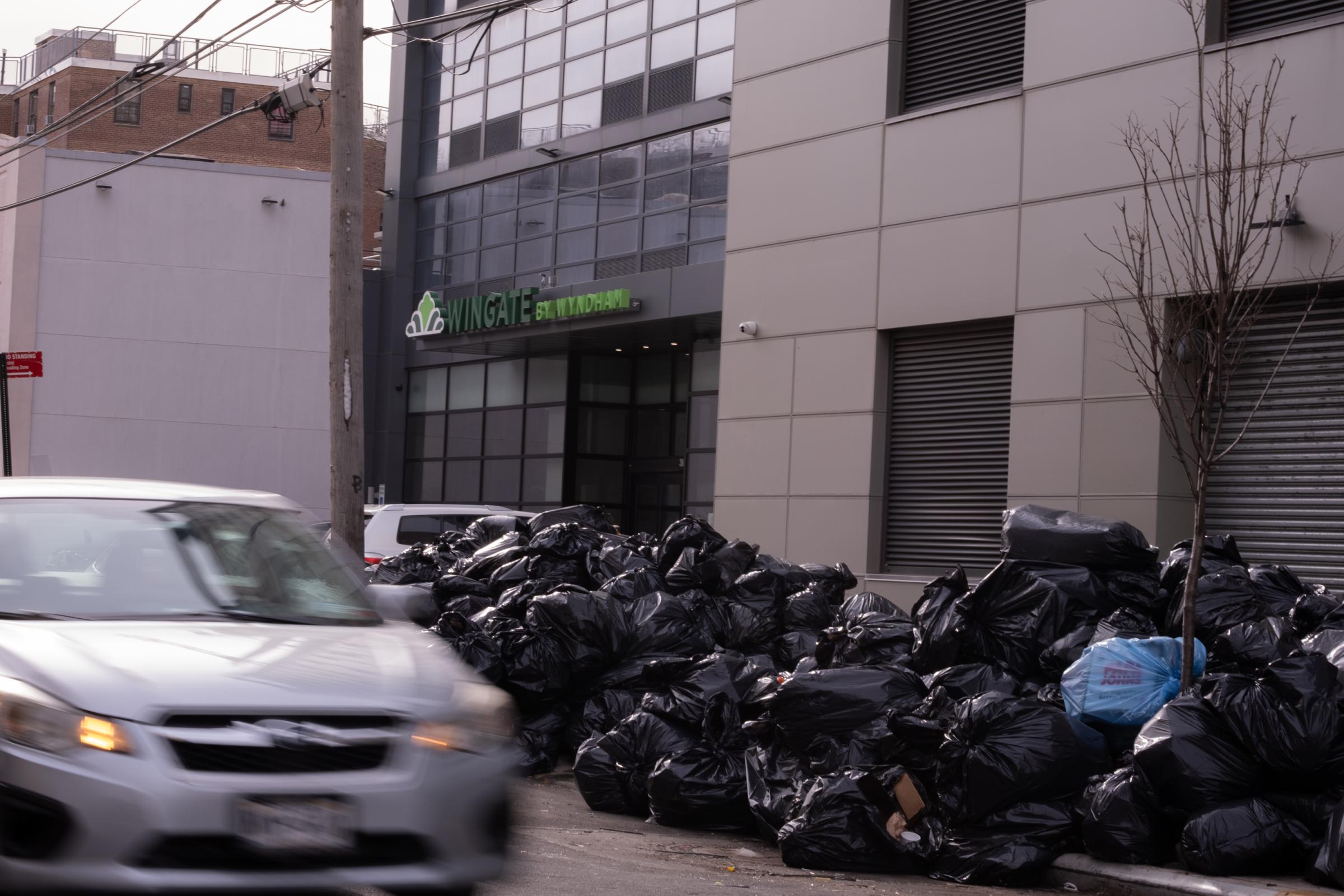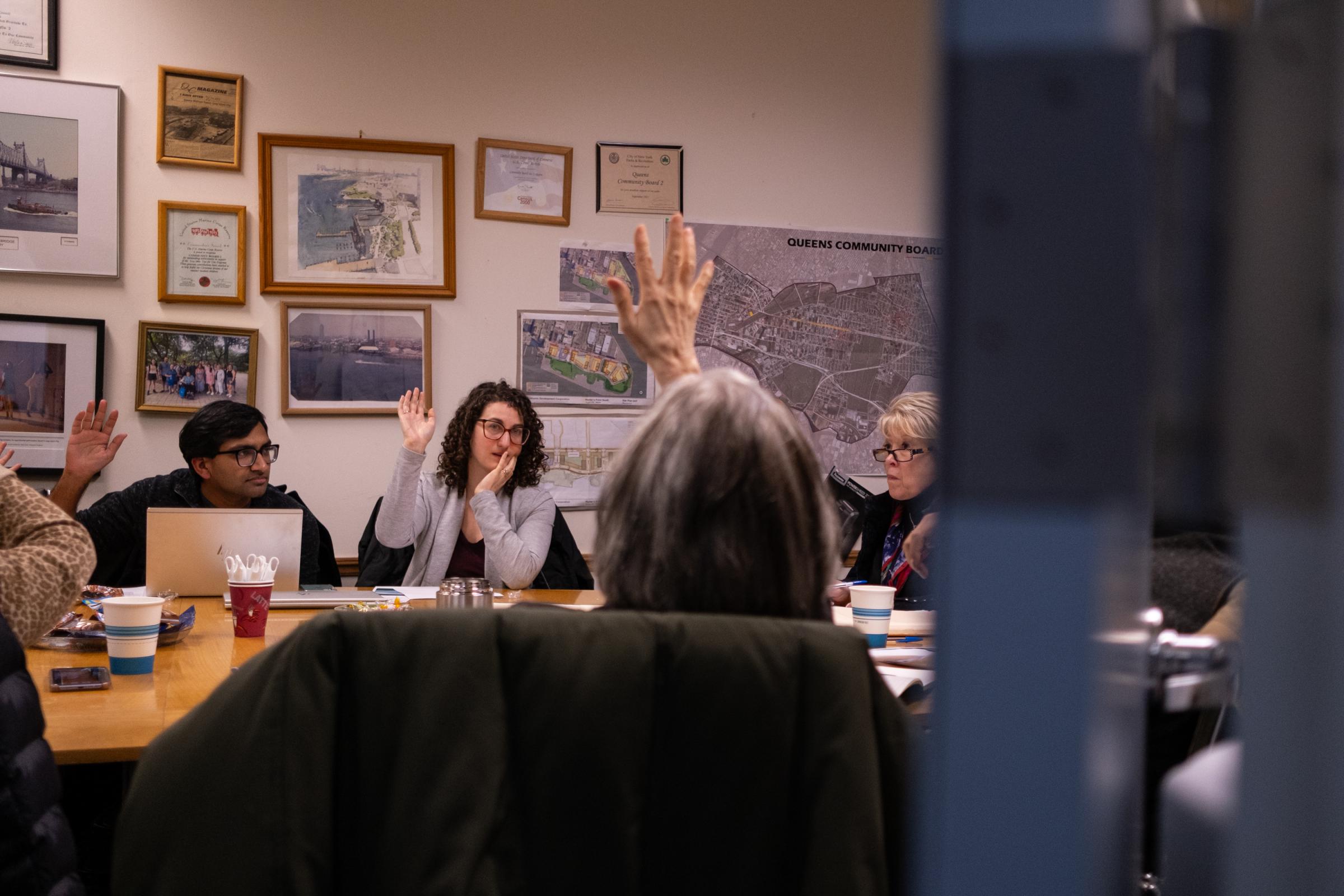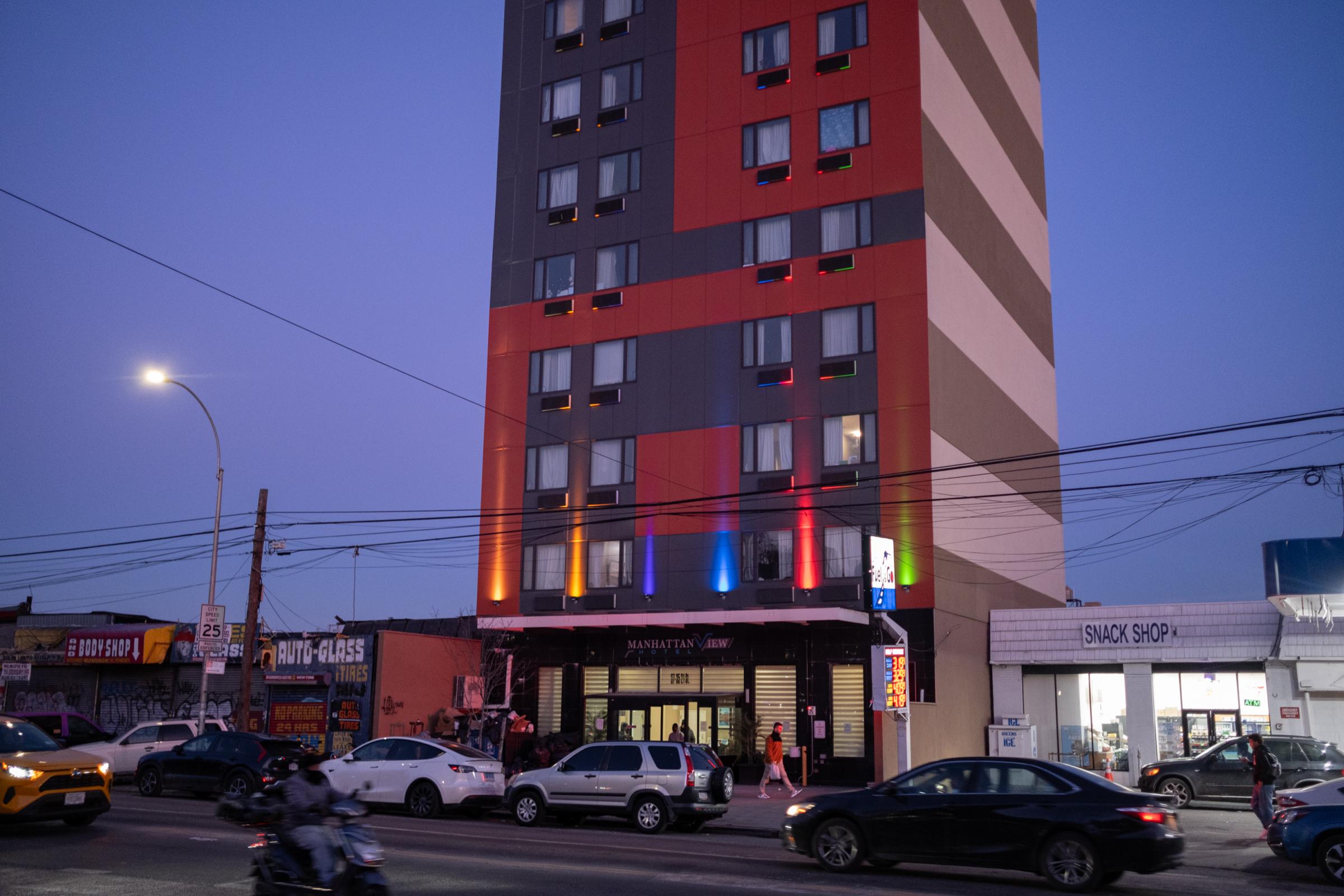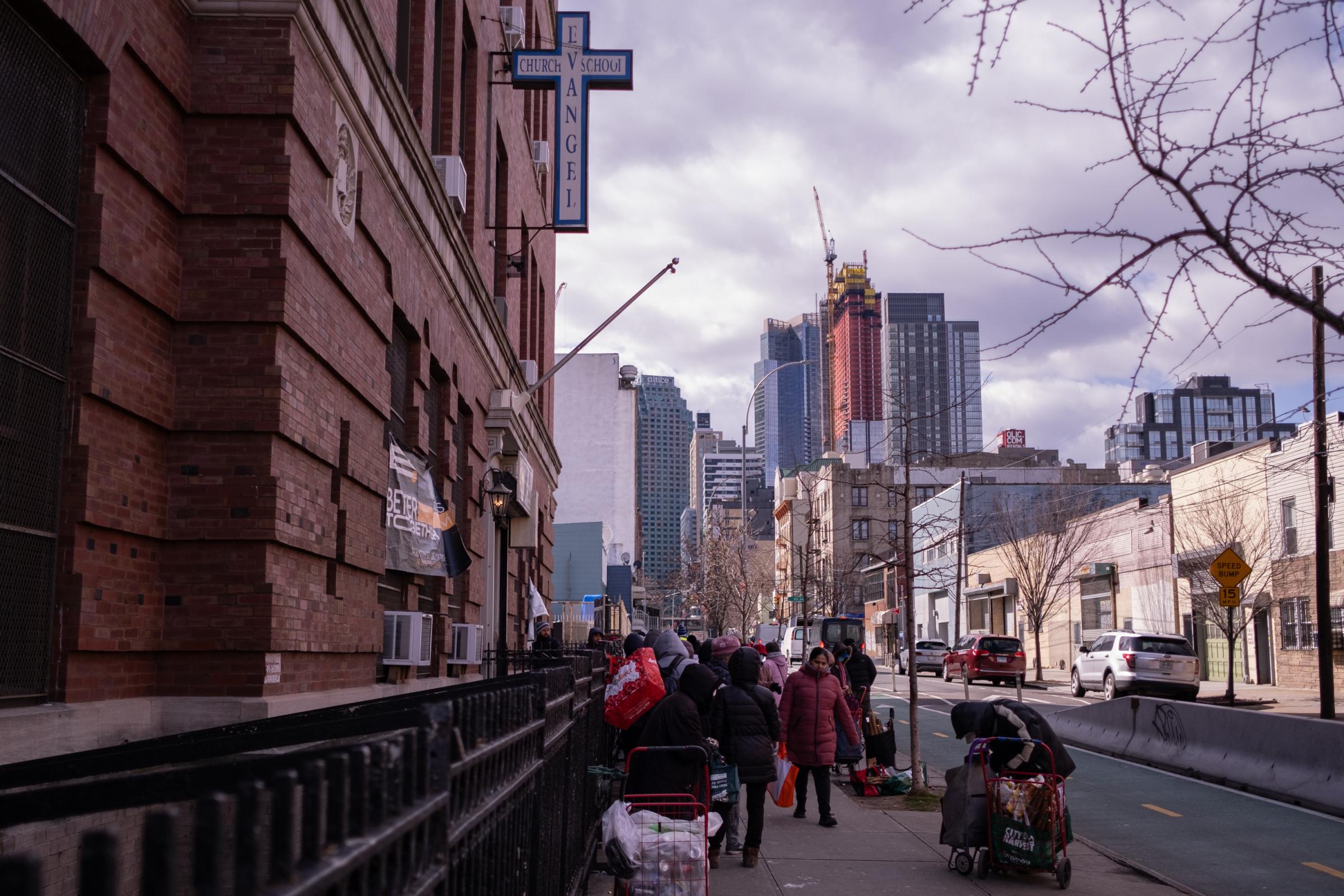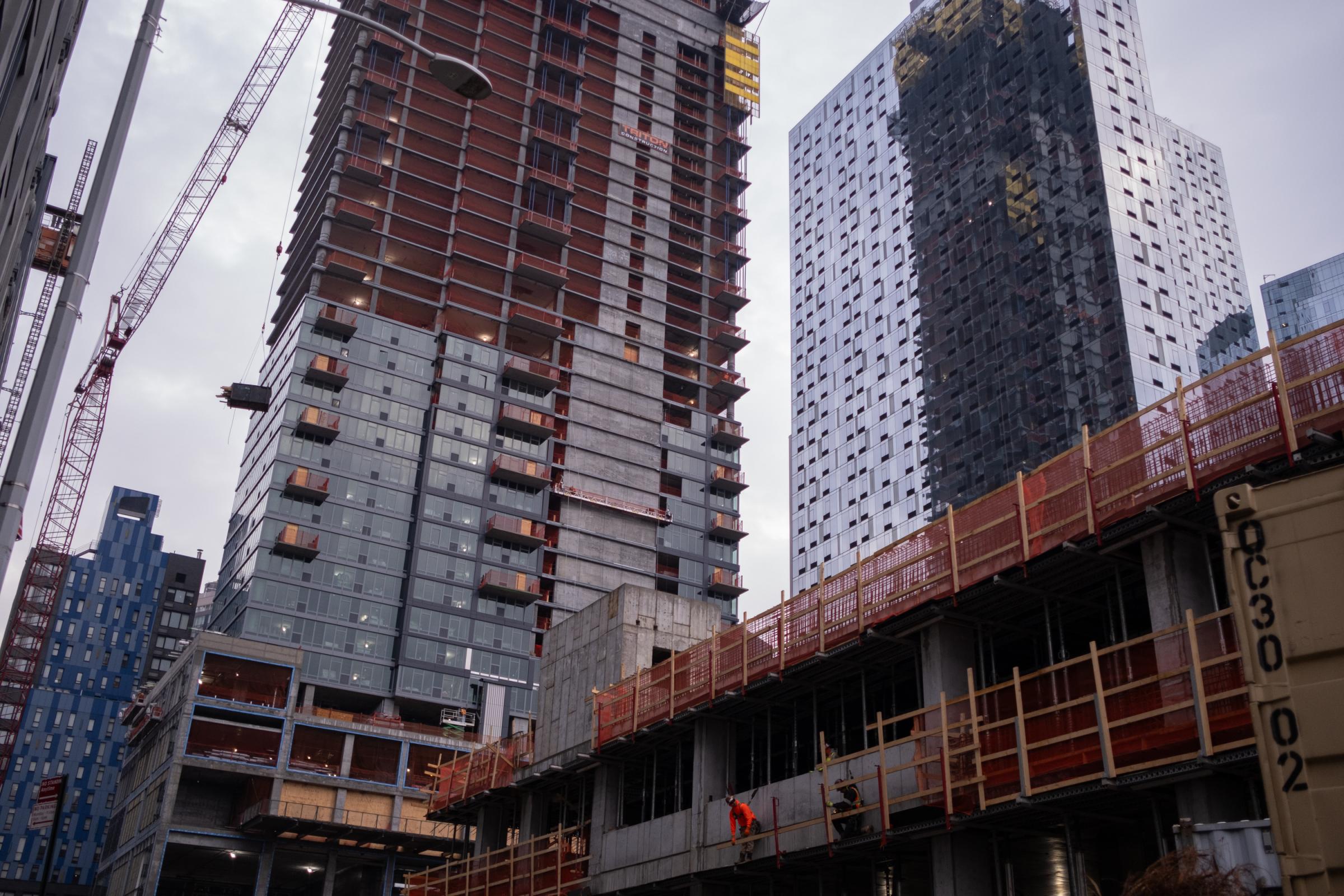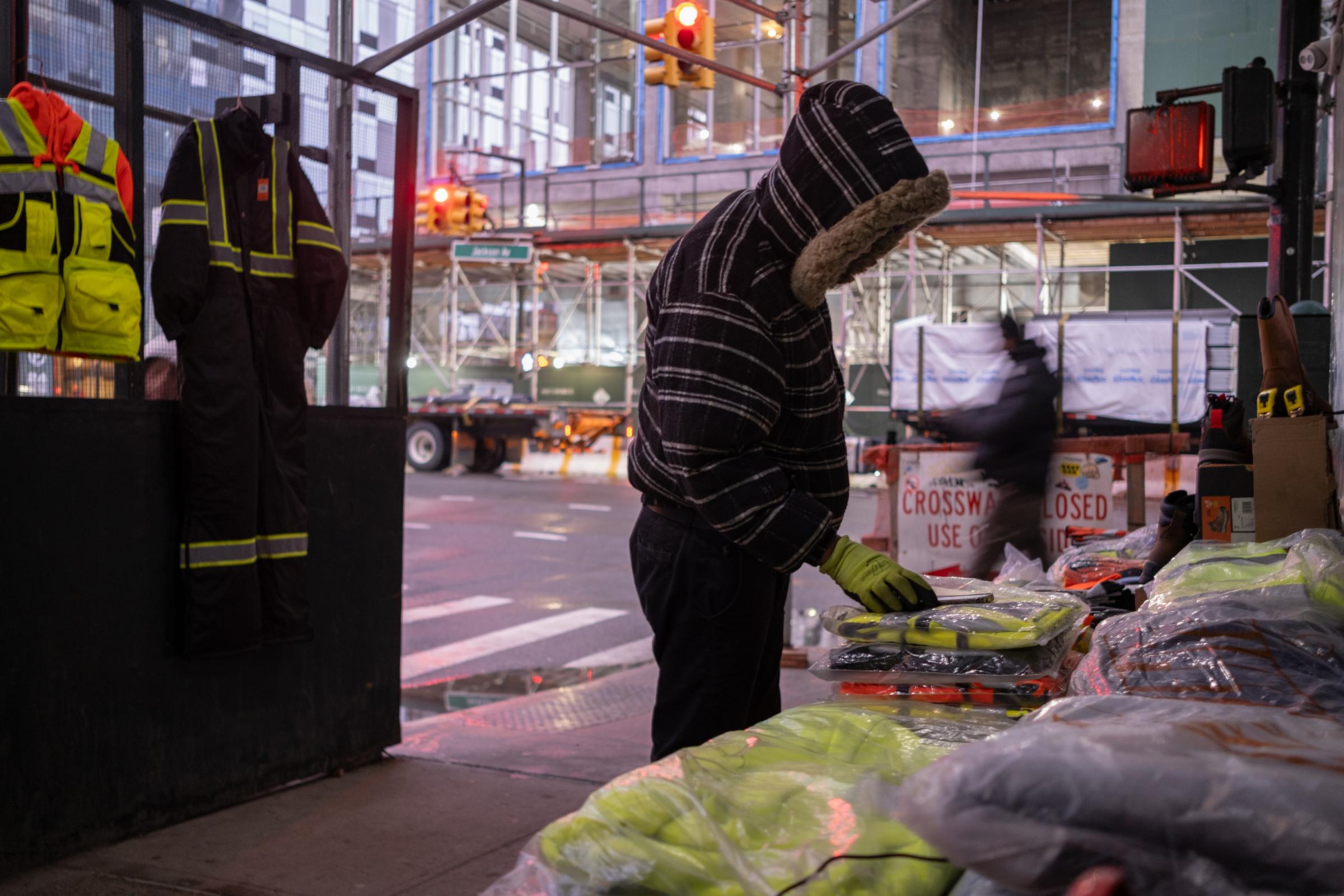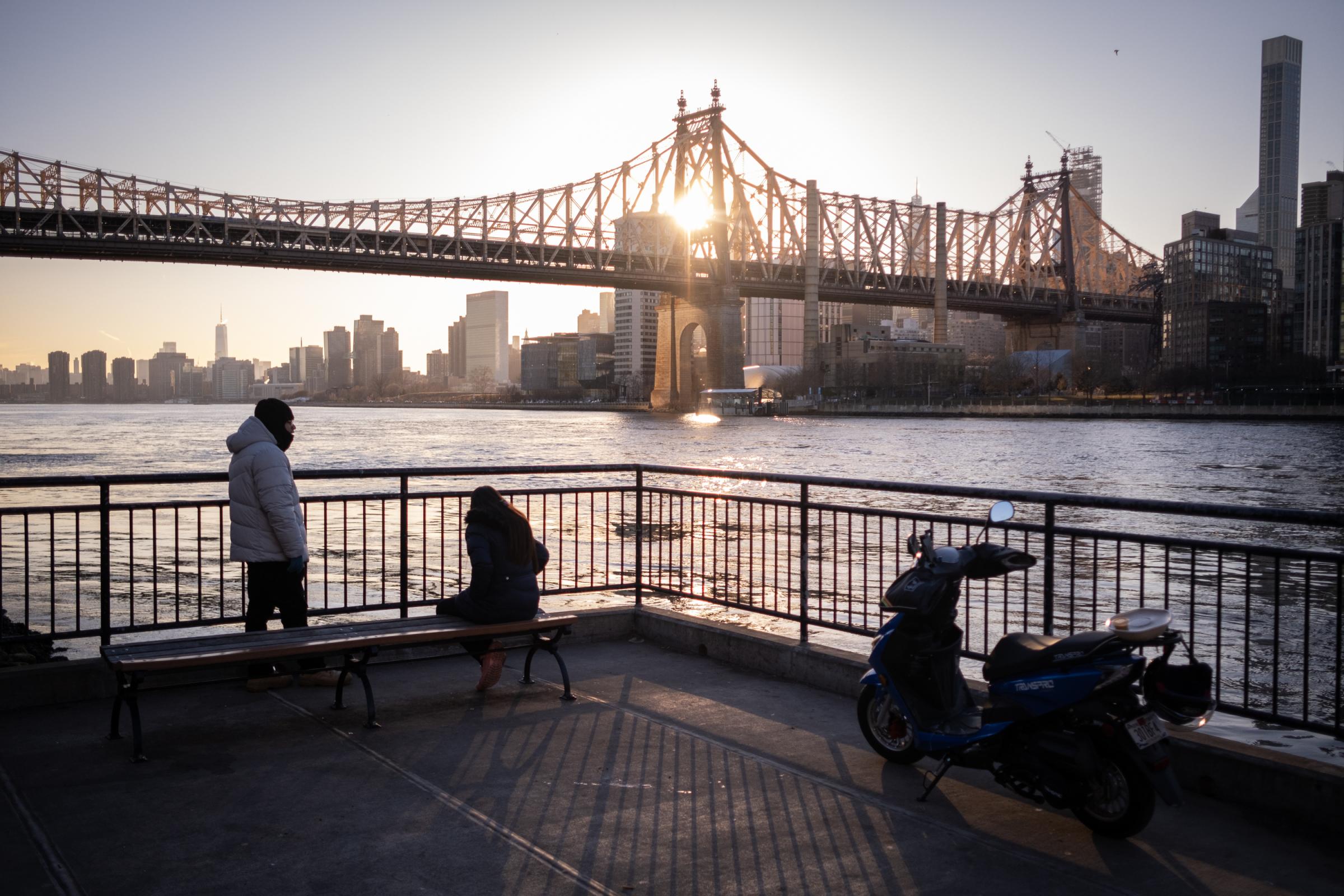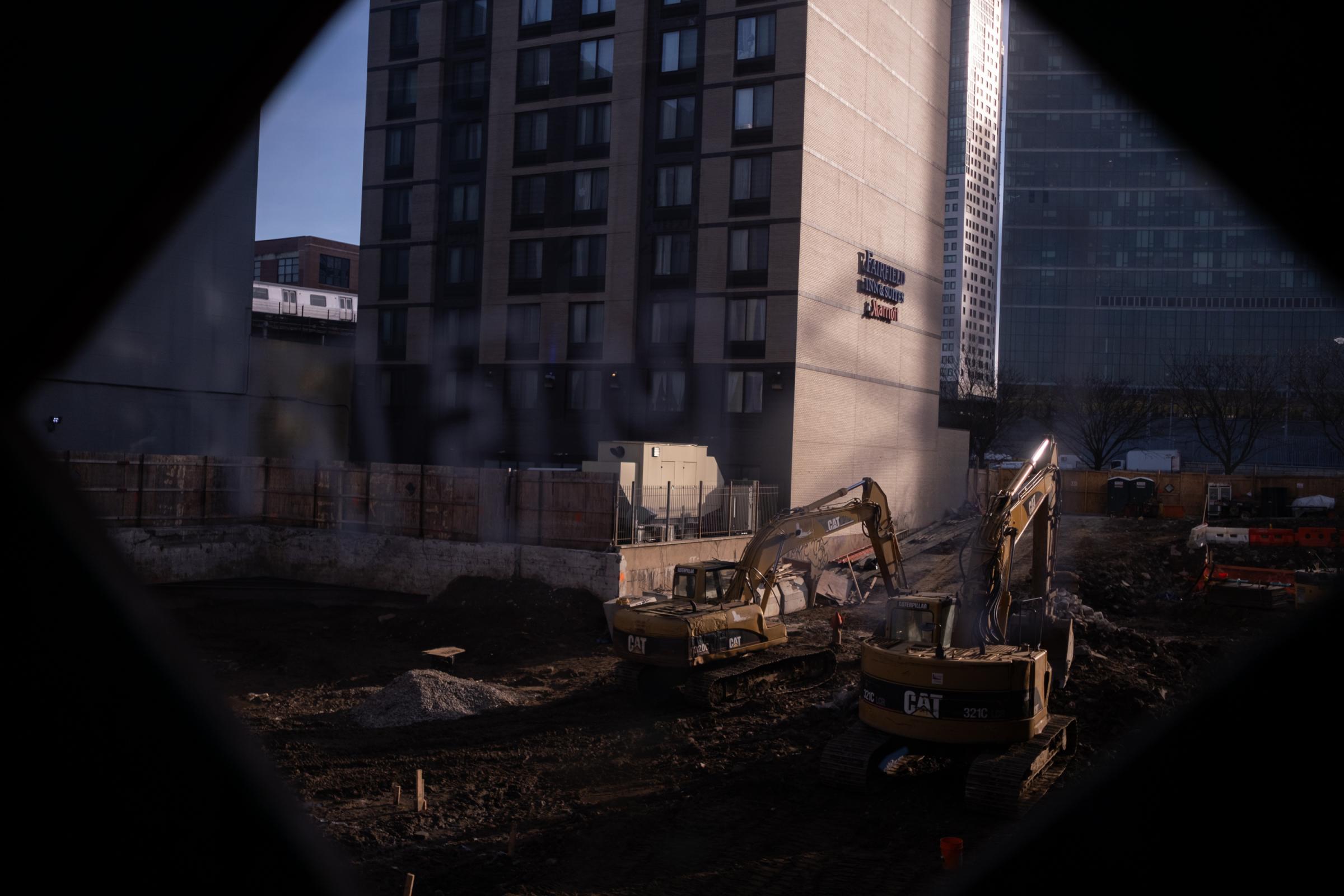Long Island City - A Neighborhood Building A Divide
Juan Carlos Parraga and his daughter Marielvis, 13, walk to the Court Square subway station in Long Island City, Queens, New York City, on Thursday, Jan. 18, 2024. Their family has been living at the Holiday Inn migrant shelter in Long Island City for five months.
Parraga is forced to cook outside because there is no access to a kitchen in the hotel and the frozen food they’re served can’t be eaten by his daughter. She suffers from cerebral palsy which makes it difficult for her to chew. Parraga had made the long arduous journey from Venezuela, carrying Marielvis for five days through the treacherous 60 mile Darien Gap on the border with Columbia and Panama with hopes of finding support and school for her in New York City and work for himself. So far, few of those dreams have been realized.
Birds fly around the old ferry terminal at Gantry Plaza in Long Island City, Queens, New York City, on Friday, Feb. 23, 2024. According to StreetEasy, an apartment research website, a rental two bedroom apartment is averaging $5,772 in the neighborhood, while the borough average is $3,000.
Parraga is one of thousands of migrants who have been assigned to the 26 migrant shelters in Long Island City (LIC). The majority of these shelters are hotels which were closed during the COVID-19 pandemic and have since reopened and repurposed to handle some of the 160,000 migrants who have arrived in New York City since the spring of 2022.
The influx of so many migrants in one neighborhood has exacerbated the growing economic disparity which has come to define Long Island City. On one hand you have luxury housing towers rising from multiple construction sites promising future residents spectacular views of the Manhattan skyline and close proximity to public transportation and amenities. On the other hand, there is intense and concentrated poverty among long-time residents living in public housing and new arrivals, crammed into hotels, doing their best to survive, but with little support from local and state officials.
No where are these pressures more evident than in the public schools. Already underfunded, these schools are scrambling to handle the influx of children, most of whom do not speak English, while navigating chaotic and disruptive city policies. The schools have also been providing services beyond basic education. They are feeding families through food pantries, distributing warm clothing and diapers and providing some mental health counseling, all paid for by donations or from their limited school operating budgets.
The influx of so many migrants in one neighborhood has exacerbated the growing economic disparity which has come to define Long Island City. On one hand you have luxury housing towers rising from multiple construction sites promising future residents spectacular views of the Manhattan skyline and close proximity to public transportation and amenities. On the other hand, there is intense and concentrated poverty among long-time residents living in public housing and new arrivals, crammed into hotels, doing their best to survive, but with little support from local and state officials.
No where are these pressures more evident than in the public schools. Already underfunded, these schools are scrambling to handle the influx of children, most of whom do not speak English, while navigating chaotic and disruptive city policies. The schools have also been providing services beyond basic education. They are feeding families through food pantries, distributing warm clothing and diapers and providing some mental health counseling, all paid for by donations or from their limited school operating budgets.
Students arrive for class at P.S. 76Q The William Hallet School in Long Island City, Queens, New York City, on Tuesday, Feb. 27, 2024. P.S. 76Q has been providing services beyond education, like distributing warm clothes and providing mental health counseling for students.
Residents of the Holiday Inn hotel leave early in the morning in Long Island City, Queens, New York City, on Tuesday, Feb. 27, 2024. The hotel is one of the 26 migrant shelters in the neighborhood.
Joelle Jackson with her eight year-old twins Tyrece and Jonece in front of the P.S. 76Q The William Hallet School in Long Island City, Queens, New York City, on Tuesday, Feb. 27, 2024. Jackson has been living in the neighborhood all her 37 years, and said that the community started to fade with the construction of luxury buildings.
But just when children start to feel safe and acclimated, city policies around shelter stays are uprooting families once again.
Construction at 43-30 24th Street takes over the skyline view of the Queensbridge houses in Long Island City, Queens, New York City, on Tuesday, Feb. 20, 2024. The public house project has an average monthly gross rent of $513.5.
Greysebel, 9, plays with her aunt Paola, middle, at the Vernon Playground, in Long Island City, Queens, New York City, on Tuesday, Feb. 20, 2024. Paola and her family are from Venezuela and live at Floyd Bennett Field, a migrant tent shelter in Marine Park, Brooklyn, built by the city. It takes them two hours and 18 minutes using public transportation to see her sister Greysimar, left, who lives at the Best Western Plus Plaza Hotel at 21st Street. (We are only using their first names to protect their identities)
The policy of 60 day hotel shelter limit frustrates Garcia. “I don’t understand why you, like, if they’re here, just let them stay, because then you’re going to be moving them to another school, and they have to start all over,” said Garcia, “We’ve had parents crying when they had to leave, you know, and the kids, they don’t want to leave because they like it here in this building.”
The Q103 bus arrives at the 40Av/12St stop in Long Island City, Queens, New York City, on Friday, March 1, 2024. Residents have expressed the lack of accessible transportation, as most of the subway trains and a ferry stop are on the other side of the neighborhood and need to be accessed by bus.
A 7 Train going to Flushing arrives at the Queensboro Plaza station in Long Island City, Queens, New York City, on Thursday, Feb. 29, 2024.
Residents of Long Island City redeem empty cans at the Fine Fare Supermarkets, inside the Queensbridge houses project, Queens, New York City, on Friday, March 1, 2024. More than 6,000 people live at the project, considered one of the largests in New York City.
Migrants have been able to put down roots in other parts of Queens, yet the long term prospects of new arrivals finding more permanent housing in Long Island City are remote. The neighborhood has been going through accelerated gentrification resulting in an affordable housing crisis and increased economic disparity. Long time residents are already feeling squeezed out and underserved.
Joelle Jackson, 37, has been a resident of Long Island City her whole life. She grew up in the Queensbridge public housing complex, one of the largest in New York City and still lives there with her two children who attend P.S. 76Q William Hallet. A neighborhood which was once affordable is now filled with luxury high rise condos with rent for a two bedroom apartment averaging $5,772 significantly higher than the borough average of $3,000 according to StreetEasy. The high prices pushed lower income people out and Jackson laments the loss of community. The wealthy residents also brought higher food prices which puts pressure on long time residents like Jackson, who relies on government assistance. “Even though a cheeseburger went from $5 to $9 we are still getting the same government funds and income,” said Jackson.
Joelle Jackson, 37, has been a resident of Long Island City her whole life. She grew up in the Queensbridge public housing complex, one of the largest in New York City and still lives there with her two children who attend P.S. 76Q William Hallet. A neighborhood which was once affordable is now filled with luxury high rise condos with rent for a two bedroom apartment averaging $5,772 significantly higher than the borough average of $3,000 according to StreetEasy. The high prices pushed lower income people out and Jackson laments the loss of community. The wealthy residents also brought higher food prices which puts pressure on long time residents like Jackson, who relies on government assistance. “Even though a cheeseburger went from $5 to $9 we are still getting the same government funds and income,” said Jackson.
Piles of trash outside of the Wingate by Wyndham migrant hotel, where Iwany and her family have been living in Long Island City, Queens, New York City, on Thursday, Feb. 15, 2024. The trash still had snow over some bags, indicating that it had been three days that these bags were accumulating.
The art piece “Sunbather” by Israeli sculptor Ohad Meromi at Jackson Avenue in Long Island City, Queens, New York City, on Friday, Feb. 23, 2024.
Birds fly around at Gantry Plaza in Long Island City, Queens, New York City, on Friday, Feb. 23, 2024. It was in the 1990s when the first luxury residential buildings started to appear in the neighborhood, like the 42-story Citylights apartment complex in 1997, at the waterfront.
Queens Community Board 2 votes in favor of supporting the Long Island City Business Improvement District partnership at their headquarters in Woodside, Queens, New York City, on Wednesday, Feb. 21, 2024. The BID will help support businesses and provide supplemental sanitation, including the 25 migrant hotels in the neighborhood.
She has mixed feelings about the influx of migrants to the community. Her children have benefited from the bi-lingual program now offered at P.S. 76Q. Already her 8 year old is speaking some Spanish. But she says some streets are more dangerous at night and both the overcrowded hotels and the numerous construction sites have made the neighborhood much dirtier.
This sentiment was echoed at a recent Community Board meeting, where residents complained about the growing sanitation crisis around the migrant shelters. They also spoke about the need for more truly affordable housing in the neighborhood and not housing based on rental prices which while deemed affordable are still out of reach for many residents. In some buildings, applicants need to have a minimum of $90,000 of yearly income.
This sentiment was echoed at a recent Community Board meeting, where residents complained about the growing sanitation crisis around the migrant shelters. They also spoke about the need for more truly affordable housing in the neighborhood and not housing based on rental prices which while deemed affordable are still out of reach for many residents. In some buildings, applicants need to have a minimum of $90,000 of yearly income.
The Manhattan View migrant shelter hotel in Long Island City, Queens, New York City, on Tuesday, Feb. 20, 2024.
An empty lot that has been in lockout at 12th Street in Long Island City, Queens, New York City, on Tuesday, Feb. 20, 2024. Residents have complained that the neighborhood has been getting dirtier in the past 10 years, especially near empty lots.
Juan Carlos Parraga cooks pasta outside the Holiday Inn migrant hotel in Long Island City, Queens, New York City, on Wednesday, Jan. 17, 2024. Parraga is forced to cook outside because there is no access to a kitchen in the hotel and the frozen food they're served can't be eaten by his daughter. She suffers from cerebral palsy which makes it difficult for her to chew.
A few blocks from P.S.76Q William Hallet on Jackson Avenue, construction workers await the 7 a.m. air horn alarm signaling the beginning of the work day. A new 69-story luxury residential skyscraper, the Orchard, is being built which will be the tallest in Queens, eclipsing in size the Skyline Tower condo, which opened in 2019. According to Michele Curevich, the superintendent on the construction site, rental apartments in the new tower will cost $5,000 a month. About 200 of the 864 apartments will be set aside for affordable housing.
People line up at Evangel Christian Center food pantry in Long Island City, Queens, New York City, on Thursday, Feb. 29, 2024. Carolyn Marko, the head pastor, said that the line for their pantry has been getting bigger since the influx of migrants started, and the pantry has been adapting to their needs by giving them snacks and instant ramen noodles since they don't have access to a kitchen.
Construction of a luxury building called the Orchard at 42-42 Orchard St. in Long Island City, Queens, New York City, on Friday, Feb. 23, 2024. According to Michele Curevich, the superintendent on the construction site, rental apartments in the new tower will cost $5,000 a month. About 200 of the 864 apartments will be set aside for affordable housing.
Ronald, from Venezuela, sells construction equipment in Long Island City, Queens, New York City, on Friday, Feb. 23, 2024. Ronald lives at the Randall's Island migrant tent shelter and commutes to the neighborhood for work, and said that 95% of the people that buy his products are migrants. (We are only using their first name to protect their identity)
Across the street from the Orchard, Ronald Veliz, a migrant from Venezuela, has set up a make-shift stand where he sells construction gear including helmets, vests and boots (We are only using their first name to protect their identity). He makes the nearly one hour journey from the Randall’s Island migrant tent shelter to LIC to sell the construction gear. He says that his biggest customers are migrants. “95% of the people who buy my products are migrants, said Veliz.” They are building the new luxury towers which will make the neighborhood out of reach for them and their families.
Hugo and Maria, from Ecuador, have a chat by the East River, at Queensbridge Park, in Long Island City, Queens, New York City, on Tuesday, Feb. 20, 2024. The couple has been in the city for two weeks, and they live at the Voyage Hotel, a migrant shelter . Maria is pregnant and they want to move to Orlando, Florida, in about six months. (We are only using their first names to protect their identities)
Construction for a luxury building at 29-15 40th Rd in Long Island City, Queens, New York City, on Friday, March 1, 2024. The building will take an entire lot between two migrant hotels used as shelter, the Microtel Inn and the Fairfield Inn & Suites, one at 40th Ave and the other at 40th Rd.
Long Island City - A Neighborhood Building A Divide

Marco Postigo Storel
Photojournalist and Photo Editor
based in New York City, New York

